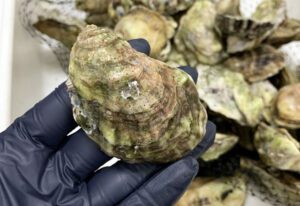
Some say, the world is your oyster, but the world — especially human impacts on the environment — can actually be found inside an oyster, according to a new study.
When FIU Institute of Environment scientists sampled 156 oysters from Biscayne Bay, Marco Island and Tampa Bay, they detected contaminants — perfluoroalkyl and polyfluoroalkyl (PFAS) and phthalate esters (PAEs) — in every single one. These contaminants pose serious health risks to people and wildlife, and the oysters prove they are in the water and have crept into the food chain. The findings were recently published in Science of the Total Environment.
“I wanted to look into what we’re eating and if it might be contaminating us,” said Leila Lemos, the study’s lead author and an FIU distinguished postdoctoral scholar. “These findings are definitely a red flag, especially for areas like Biscayne Bay.”
As filter-feeders, oysters are among the best sentinels and can reveal a lot about the overall health of an ecosystem including levels of contamination.
Biscayne Bay oysters had the highest concentrations of contaminants compared to the other study sites. Lemos says this was somewhat surprising since they were among the smallest oysters sampled. The more time an oyster has to grow, the more time it also has to accumulate toxic chemicals. Tampa Bay oysters were among the largest in the study, but they didn’t have nearly the amount of PFAS or PAEs as the tinier Biscayne Bay oysters. This means Biscayne Bay could be so contaminated, the oysters are bombarded with such high concentrations they accumulate contaminants more quickly, Lemos said.
The contaminants are likely interfering with the oysters’ growth, she said, making their small size another clue. In fact, there was a strong correlation between the amount of PFAS in the water and an oyster’s shell thickness and weight. The oysters with the highest concentrations of contaminants had the thinnest shells. The number of contaminants in the area could impair their development — which raises concerns for how chemical contaminants could threaten oyster farming in other parts of the country.
The study also assessed the human health risk of consuming oysters. In this study, the Tampa Bay oysters originated from an oyster farm, so Lemos examined those samples. The good news is the health risk is low. However, Lemos points out current assessments only include four PFAS and four PAEs compounds — and don’t look at the majority of compounds. The assessment also does not look at the risks of consuming other marine life that may live the same waters with the oysters with high contamination.



